雅思阅读练习题:Global warming
英赛特·雅思 吴建业主编 《IELTS 7+ 写作》
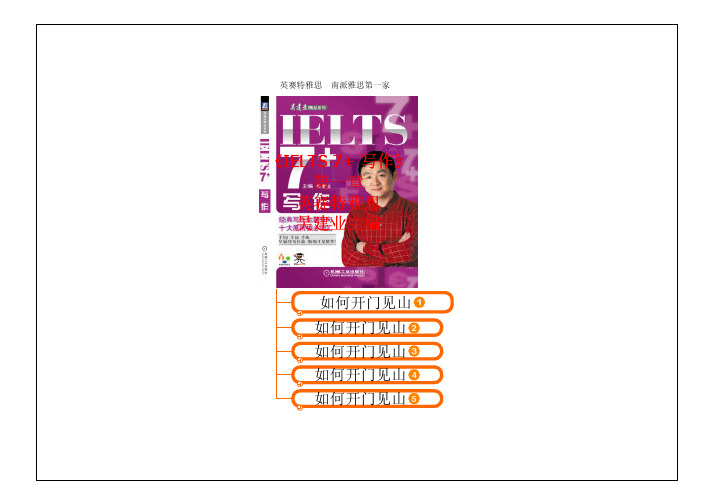
《IELTS 7+ 写写》第第第英英英英英] In recent years, freshwater shortage has attracted increasing attention in both developed and developing nations.近近近,淡淡淡淡淡淡淡淡淡淡淡淡淡淡淡淡淡淡淡淡淡淡。
] 1. global warming] Extinction of endangered species has become a global concern.] Teen pregnancy and drug abuse have become big problems in western countries.青青青青青青青青青青青青青青青青青青青青青青青青。
] 1.teenage adj.] Population aging is a worldwide problem and it has many potential consequences.人人人人人人人人人人人,将将将将将将将将将将。
果果] Capital punishment continues to be a highly contentious debate around the globe.]One of the most controversial issues of recent days is organ transplant.英赛特雅思 南派雅思第一家] Teenage crime is a topic of public and media concern.英赛特雅思 南派雅思第一家]Housing shortage has become the hottest issue lately.] 1. shortage n.2. Global warming has become the most talked-about environmental issue today.]Freshwater scarcity has become the most talked-about environmental issue today.]A great deal of media attention has been directed to school bullying in recent years.近近近,媒媒媒媒媒媒媒媒媒媒媒媒媒。
雅思英语作文Global warming 全球变暖是当今世界面临的最严重问题,是什么原因,如何解决?
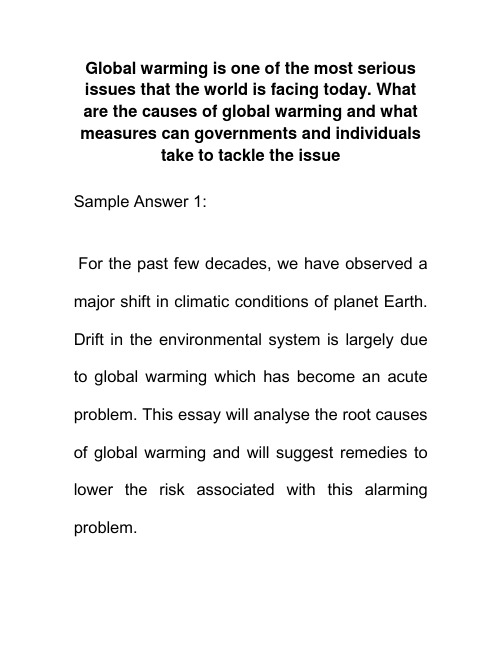
Global warming is one of the most serious issues that the world is facing today. What are the causes of global warming and what measures can governments and individualstake to tackle the issueSample Answer 1:For the past few decades, we have observed a major shift in climatic conditions of planet Earth. Drift in the environmental system is largely due to global warming which has become an acute problem. This essay will analyse the root causes of global warming and will suggest remedies to lower the risk associated with this alarming problem.There are many causes of global warming, but it is mostly due to the greenhouse effect. The greenhouse effect is a phenomenon where gases such as carbon dioxide trap heat from the sun which causes the global temperature to rise above optimal level. Activities of human beings contribute equally to the increase of global warming. Factories and vehicles result in the emission of carbon gases and fumes which are depleting the ozone layer surrounding the earth. Utilisation of fossil fuels and other hazardous chemicals are other reasons of global warming. Moreover, countries are becoming more industrialised and are dumping waste into theatmosphere without realising its harmful effects and severity of the issue. Rising temperatures due to global warming would result in melting of polar ice-caps which will trigger severe floods, droughts and other extreme weather conditions.This critical issue which could potentially eliminate the human race should be death on government and individual level. Governments should enforce strict policies and regulations to control the emission of carbon gases from industries. More focus should be made on using alternative petroleum products that are environment-friendly. Industries that are certifiedgreen should be charged lower tax rate. Awareness programs should be organised to educate masses. Apart from government, individual members of the society should step forward and play their role. People should select green vehicles for their transportation requirement; they should dump the waste properly, prefer to work in green certified industries and educate others.To conclude, global warming poses a serious threat to mankind, wildlife and ecosystem of the planet. Governments and civilians both share equal responsibility to overcome this issue andmake planet earth safer for mankind and other inhabitants.Sample Answer 2:Global warming is a serious worldwide problem that arises as an effect of gases like Carbon Dioxide traps the heat from the sun causing the rise in the global temperature, this process is known as greenhouse effects which have many causes believed to be a human effect. There are many different measures that could be taken to tackle this pressing matter.The main causes of global warming are due to human activities such as deforestation, building factories, driving more cars, increasing numbers of aeroplanes etc. Human usage many fuels and fossils and these all lead to the production of gases and hence rising in global temperature, also the greatest increase in the number of the population leading to a great decline in natural resources. Moreover the over-cutting of trees and destruction of wild life habitats which will lead to animal extinction at the end, this all are causes of global warming.Global warming has serious effects on the environment which are increasing of sea level and arising of floods and droughts, melting of polar ice cap which in turn leads to extreme weather conditions.There are some solutions that governments and individuals should take in order to prevent and put an end to this problem; firstly to put limitations for energy consumption by factories and implementation of other renewable sources of energy such as solar energy and water power. Also, governments should organise some campaigns that would promote waste recycling,put rules to protect wild life, and encourage the growing of more and more trees. Furthermore, governments and individuals could decrease the energy consumption by decreasing the number of flights, using public transport to decrease using of cars. Eco-friendly transportation like Bicycle should be used and the number of private cars should be decreased.As a summary global warming is a serious worldwide issue that arises from human activities which need the participation of both the governments and the individuals to be ended.。
高考英语一轮复习提能练(二十九)Unit4Globalwarming(含解析)

Unit 4 Global warmingⅠ.阅读理解A(2020·“四省八校”高三第二次质量检测) Fires sweeping across the Amazon rainforest this year have been a hot topic as scientists and environmental groups are worried that they will worsen the climate change crisis and threaten biodiversity(生物多样性).As the largest rainforest in the world,the Amazon rainforest is often called “the lungs of the world”.It is also home to about 3 million species of plants and animals,and 1 million native people.The vast areas of the rainforest play an important role in the world's ecosystem because they absorb heat instead of it being reflected back into the atmosphere.They also store carbon dioxide and produce oxygen,ensuring that less carbon dioxide is released,mitigating the effects of climate change.“Any forest destroyed is a threat to biodiversity and people,” Thomas Lovejoy,an ecologist at George Mason University told National Geographic.“The overwhelming threat is that a lot of carbon dioxide goes into the atmosphere,”he stressed.“In the midst of the global climate crisis,we cannot afford more damage to a major source of oxygen and biodiversity.The Amazon rainforest must be protected,”U.N.Secretary General António Guterres said.Data from the National Institute for Space Research(INPE) show that the number of forest fires in Brazil quickly increased by 82 percent from January to August this year pared to the same period last year.A total of 71,497 forest fires were registered in the country in the first eight months of 2019,up from 39,194 in the same period in 2018,INPE said.“We estimate that the forest areas in the Brazilian Amazon rainforest have decreased by between 20 and 30 percent pared to the last 12 months,”Carlos Nobre,a researcher at the University of Sa~o Paulo,told German broadcaster Deutsche Welle.Brazil owns about 60 percent of the Amazon rainforest,whose degradation(恶化) could have severe consequences for global climate and rainfall.The extent of the area ruined by fires has yet to be determined,but the emergency has transcended(超出)Brazil's borders,reaching Peruvian,Paraguayan and Bolivian regions.语篇解读科学家和环保组织担心席卷亚马孙雨林的火灾将加剧气候变化危机,威胁生物多样性。
雅思作文 global warming
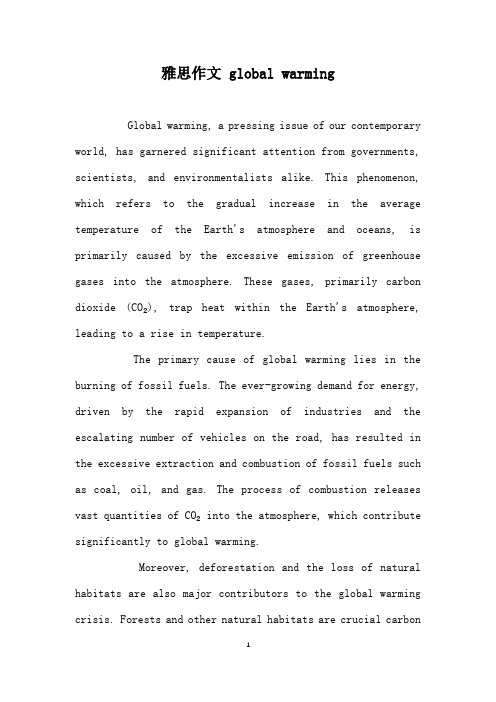
雅思作文 global warmingGlobal warming, a pressing issue of our contemporary world, has garnered significant attention from governments, scientists, and environmentalists alike. This phenomenon, which refers to the gradual increase in the average temperature of the Earth's atmosphere and oceans, is primarily caused by the excessive emission of greenhouse gases into the atmosphere. These gases, primarily carbon dioxide (CO₂), trap heat within the Earth's atmosphere, leading to a rise in temperature.The primary cause of global warming lies in the burning of fossil fuels. The ever-growing demand for energy, driven by the rapid expansion of industries and the escalating number of vehicles on the road, has resulted in the excessive extraction and combustion of fossil fuels such as coal, oil, and gas. The process of combustion releases vast quantities of CO₂ into the atmosphere, which contribute significantly to global warming.Moreover, deforestation and the loss of natural habitats are also major contributors to the global warming crisis. Forests and other natural habitats are crucial carbonsinks, absorbing and storing carbon dioxide from the atmosphere. However, the unchecked clearing of forests for agricultural purposes, urbanization, and timber extraction has significantly reduced their carbon-storing capacity.To tackle the challenge of global warming, several measures can be implemented. Firstly, a transition to renewable energy sources such as solar, wind, and hydroelectricity must be accelerated. These clean energy sources emit minimal greenhouse gases, reducing the overall carbon footprint.Secondly, policies aimed at reducing carbon emissions from the transportation sector are crucial. This includes promoting the use of electric vehicles, improving public transportation systems, and encouraging cycling and walking as viable modes of transportation.Thirdly, reforestation and the protection of natural habitats must be prioritized. Governments and non-governmental organizations should work towards preserving existing forests and establishing new ones to enhance the carbon-storing capacity of the Earth.Finally, it is imperative to raise awareness about the dangers of global warming and the importance ofsustainable practices. Educational programs and campaigns should be launched to inform the general population about the issue and encourage them to adopt a more environmentally-conscious lifestyle.In conclusion, global warming is a complex issue that requires a multifaceted approach to address. By implementing measures such as transitioning to renewable energy, reducing carbon emissions from transportation, protecting natural habitats, and raising public awareness, we can contribute towards mitigating the effects of global warming and preserving our planet for future generations.。
高中英语真题:Unit4 Globalwarming_4
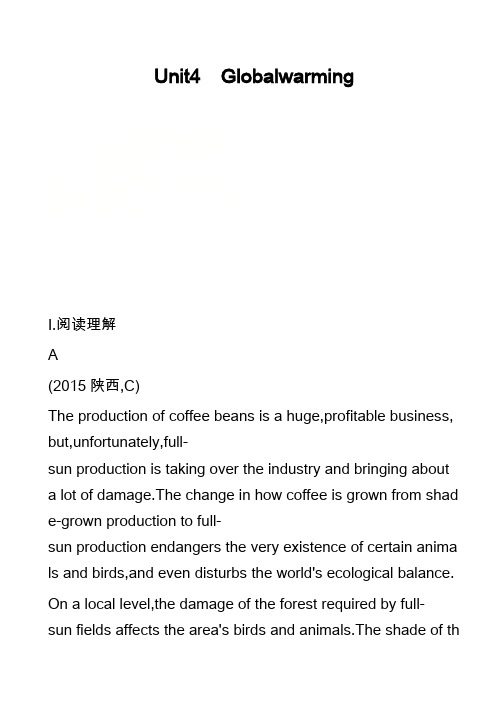
Unit4 GlobalwarmingⅠ.阅读理解A(2015陕西,C)The production of coffee beans is a huge,profitable business, but,unfortunately,full-sun production is taking over the industry and bringing about a lot of damage.The change in how coffee is grown from shad e-grown production to full-sun production endangers the very existence of certain anima ls and birds,and even disturbs the world's ecological balance. On a local level,the damage of the forest required by full-sun fields affects the area's birds and animals.The shade of the forest trees provides a home for birds and other species(物种)that depend on the trees' flowers and fruits.Full-sun coffee growers destroy this forest home.As a result,many species are quickly dying out.On a more global level,the destruction of the rainforest for full-sun coffee fields also threatens(威胁)human life.Medical research often makes use of the forest s' plant and animal life,and the destruction of such species co uld prevent researchers from finding cures for certain disease s.In addition,new coffee-growing techniques are poisoning the water locally,and event ually the world's groundwater.Both locally and globally,the continued spread of full-sun coffee plantations(种植园)could mean the destruction of the rainforest ecology.The lo ss of shade trees is already causing a slight change in the wo rld's climate,and studies show that the loss of oxygen-giving trees also leads to air pollution and global warming.Mor eover,the new growing techniques are contributing to acidic(酸性的)soil conditions.It is obvious that the way much coffee is grown affects many a spects of life,from the local environment to the global ecology. But consumers do have a choice.They can purchase shade-grown coffee whenever possible,although at a higher cost.Th e future health of the planet and mankind is surely worth more than an inexpensive cup of coffee.1.What can we learn about full-sun coffee production from Paragraph 4?A.It limits the spread of new growing techniques.B.It leads to air pollution and global warming.C.It slows down the loss of shade trees.D.It improves local soil conditions.2.The purpose of the text is to .A.entertainB.advertiseC.instructD.persuade3.Where does this text probably come from?A.An agricultural magazine.B.A medical journal.C.An engineering textbook.D.A tourist guide.4.Which of the following shows the structure of the whole text ?(P:Paragraph)B(2018河南郑州一中高三入学考试,B)Enjoying a musical performance no longer requires a costly ti cket or a trip to a theater. These days, musicians are performi ng in private homes, in salons, at airports...even on ferryboats .Musicians like house concerts. At music clubs, they often hav e to perform over the loud conversation or deal with people w ho have drunk too much alcohol. People at house concerts ar e more focused on listening to the music.Just a few hours before the Bombadils started singing in the O'Hair Salon, Lindsay was having her hair cut and Tamera wa s having facials. Then, they moved chairs and microphones to create a small performance space. The Bombadils played mu sic in the front part of the hair salon, near the hair dryers and dressing table.“This is our first show in a hair salon,”Sarah Frank of the Bom badils told concertgoers at last week's performance. Frank sai d she and band members Luke Fraser and Kaitlyn Raitz hada great time “interacting” with the audience.Concerts in people's homes, or small businesses such as O'H air are becoming more and more popular, musicians say. “Th ere is a more relaxed atmosphere,”said Domenic Cicala, the o wner of the salon.“People really get to know the artists.”At house concerts, people get time before and after concerts t o meet the performers. Very often the hosts or guests will pro vide food and drink.“People really like listening to music in the living room of a frie nd,”said Matt Hart, making up Local Strangers a folk-rock group based in Seattle with Aubrey Zoli. At many such c oncerts, the musicians do not need microphones. However, e very word of their songs can be heard.5.Why do musicians like house concerts?A.Because private homes are easier to get to.B.Because people pay more attention to their music.C.Because they can do other things while performing.D.Because they don't have to bring their microphones.6.What impressed Sarah Frank most at her last week's perfor mance?A.The small performance space.B.Her first show in a hair salon.C.Their “interacting” with the audience.D.The more relaxed atmosphere.7.How many music groups are mentioned in the text?A.One.B.Two.C.Three.D.Four.8.What may be the best title for the text?A.Musicians struggle to make a livingB.People really get to know the artistsC.Musicians find new places to performD.Concertgoers won't go to music clubsⅡ.语法填空(2018山西重点中学协作体高三一联)阅读下面短文,在空白处填入1个适当的单词或括号内单词的正确形式。
2019年雅思阅读全真习题:全球变暖

2019年雅思阅读全真习题:全球变暖本系列的模拟试题在难度、长度、题材、题型方面都与雅思考试近似的练习。
这些练习,均以国外报刊上的文章为素材,按雅思阅读的题型,出题并提供答案及简单注释。
实行雅思复习的同学能够在网页直接做题或将题目打印练习均可。
Global warmingYou should spend about 20 minutes on Questions 1-13 which are based on Reading Passage 1 below.Questions 1-5 Reading Passage 1 has six paragraphs A-F .Choose the most suitable headings for paragraphs B-F from the list of headings below.Write the appropriate numbers i-viii in boxes 1 - 5 on your answer sheet.List of Headingsi The plaintiffs?viewpoints on regulating emissionii Federal government being taken to courtiii Possible impact of the case on other lawsuitsiv Regulating air pollution by twelve Statesv Stance of the Bush administrationvi Viewpoints of Bill Clinton on regulationvii The call for emission caps and reductionviii Uncertainty in ruling by the Supreme CourtExample AnswerParagraph A ii1. Paragraph B _____2. Paragraph C _____3. Paragraph D_____4. Paragraph E _____5. Paragraph F _____Green states take the federal government to courtNov 30th 2006From The Economist print editionA WHEN the subject is global warming,the villain is usually America . Although it produces a quarter of the greenhouse gases that are heating up the planet,it refuses to regulate them. When other countries agreed on an international treaty to do so——he Kyoto protocol——America failed to ratify it. But not all American officialdom is happy with the federal government's stance. In fact,12 states disagree so fiercely that they are suing to force it to curb emissions of carbon dioxide,the most common greenhouse gas. The Supreme Court heard argument in the case on November 29th. The outcome will not be known for months,but the political wind seems to be shifting in favour of firmer action to counter climate change.B The Clean Air Act charges the Environmental Protection Agency (EPA) with regulating air pollution from vehicles. Butthe EPA argues that Congress did not intend to include CO2 under that heading,and that to do so would extend the EPA's authority to an unreasonable extent. Furthermore,it contends that regulating emissions would not do good unless all ormost other countries did the same. That is in keeping withthe policies of President George Bush,who opposes mandatory curbs on emissions and believes that any international accord on global warming should apply to all countries——unlike the Kyoto protocol,which exempts poor ones,including bigpolluters such as China and India . Ten states,among themgas-guzzling Texas and car-making Michigan,also back the EPA.C The plaintiffs comprise 12 states,three cities,various NGOs,and American Samoa,a Pacific territory in danger of vanishing beneath the rising ocean. They are supported by a further six states,two power companies,a ski resort,and assorted clergymen,Indian tribes and agitated grandees such as Madeleine Albright,a former secretary of state. They point out that under the administration of Bill Clinton,the EPA decided that it did have the authority to regulate CO2. The act,they note,says the EPA shouldregulate any air pollutant that "may reasonably beinterpreted to endanger public health or welfare". It goes on to define public welfare to include "effects on soils,water,crops,vegetation,manmade materials,animals,wildlife,weather,visibility,and climate".D The Supreme Court may give a mixed ruling,decreeingthat carbon dioxide is indeed a pollutant,but one the EPA is free to ignore or regulate as it pleases. Or it might dismiss the complaint on the grounds that the plaintiffs did not have the right to lodge it in the first place. In theory,they。
unit5globalwarming视听说文本与练习答案
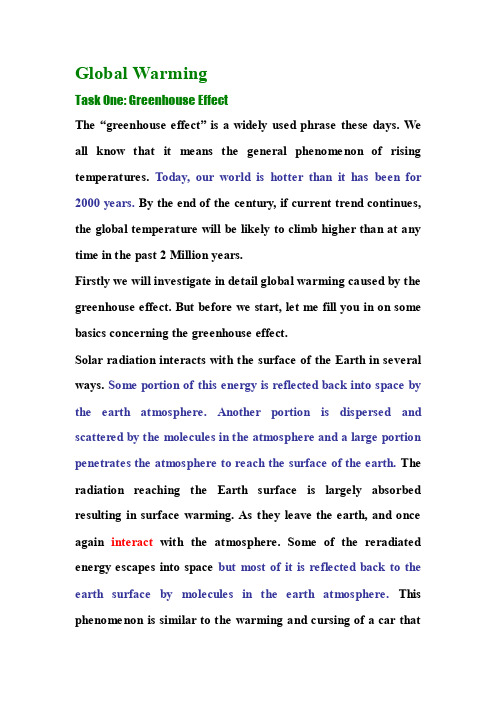
Global WarmingTask One: Greenhouse EffectThe “greenhouse effect” is a widely used phrase these days. We all know that it means the general phenomenon of rising temperatures.Today, our world is hotter than it has been for 2000 years. By the end of the century, if current trend continues, the global temperature will be likely to climb higher than at any time in the past 2 Million years.Firstly we will investigate in detail global warming caused by the greenhouse effect. But before we start, let me fill you in on some basics concerning the greenhouse effect.Solar radiation interacts with the surface of the Earth in several ways. Some portion of this energy is reflected back into space by the earth atmosphere. Another portion is dispersed and scattered by the molecules in the atmosphere and a large portion penetrates the atmosphere to reach the surface of the earth. The radiation reaching the Earth surface is largely absorbed resulting in surface warming. As they leave the earth, and once again interact with the atmosphere. Some of the reradiated energy escapes into space but most of it is reflected back to the earth surface by molecules in the earth atmosphere. This phenomenon is similar to the warming and cursing of a car thatis parked outside on the sunny day. The molecules responsible for this phenomenon are called green house gases. In essence, green house gases act like an insulator or blanket above the earth keeping the heat in. Increasingly concentration of these gases increases atmosphere’s ability t o grow or escape the infrared radiation. In other words, the earth’s insulator gases get thicker. That is what we called the “greenhouse effect”.Task Two: Climate ChangeAn environmental studies professor at Stanford University says, “(Quote) There’s no w ay. There’s anything natural that can explain it.” A professor of atmospheric sciences at MIT says, it’s part of the natural warming and cooling a planet goes through. Well, they’re talking about transitions in the earth’s temperature, something Carl Azuz now boils down to the basics.(Carl Azuz)In a world that’s always changing,there’s one thing that ma ny folks want to stay the same: the temperature. A change of just a couple degrees, can make a world of difference, and not necessarily a good one. The Ea rth’s average temperature fluctuates, going through both warming and cooling periods. The last cooling off period was between 1945 and 1975.Since then, though, things have been steadily heating up. And mostscientists point to Arctic ice melting as proof; something Anderson Cooper saw firsthand.(Anderson Cooper)Already in the last 30 years, at least 400,000 square miles of sea ice has melted. That’s about the size of Texas and California combined. And as the ice melts it affects sea levels around the world, which impacts tens of millions of people.(Azuz)What’s controversial about climate change is whether peop le have anything to do with it. A change in the Earth’s orbit or the sun’s radiation could cause global warming.But so could an increase in greenhouse gases.The Earth needs these gases to maintain a warm, livable environment. But they contain carbon dioxide, which has increased dramatically over the last couple centuries. This may be due to car emissions, burning fossil fuels, deforestation. Many scientists blame all of it for causing the world to warm up. But is it all just theory, another planetary “summer” before “fall”,or are we headed for severe drought, consuming fires and melted ice caps?Task Three: Cracks in the Ice(Carl Azuz)Hi, I’m Ca rl Azuz. However you are watching this edition ofCNN Student News, we’re glad you are. Thanks for tuning in this Thursday.(Azuz)First up, we’re heading south to Antarctica, where it’s cold, but apparently not cold enough. A huge chunk of ice broke away from the continent this week, and some scientists are blaming it. on the changing climate. Now, since Antarctica is south of the equator, summer just ended down there. So, this is the time when major events like this are most likely to happen. Emily Chang has more details now on the icy breakup.(Emily Chang)Scientists fly over a giant chunk of Antarctic ice as it cracks and collapses. The chunk is enormous, about 7 times the size of Manhattan, 160 square miles. It was part of the Wilkins ice shelf, the biggest on Antarctica yet, scientists say, to fall victim to global warming.(David V aughn, British Antarctic Survey)Watching Wilkins ice shelf disappear at the moment, we learn a lot more about how ice responds to climate change.(Chang)The ice is just a small fraction of the Antarctic ice sheet, but it broke off well before scientists predicted, a sign they say thatclimate change might be happening faster than expected. One expert told us last year.(Lonnie Thompson, Glaciologist)I think what we do know is that ice is probably the best sensor of these large scale changes taking place. And in many ways, I think we’re in uncharted territory.(Chang)Ice plays a vital role in cooling the Earth’s temperature and regulating sea levels. As it’s lost,the planet gets warmer, sea levels rise and more ice is threatened. A vicious environmental circle!By the end of the century, many experts project sea levels will rise between 7 and 23 inches, and temperatures could increase by up to 7 degrees Fahrenheit. But some say those estimates are too conservative.(James Hansen, NASA Climate Scientist)There are glaciologists now who are getting very worried. But they haven’t really come out and said what they think. (Chang)This part of the Antarctic is warming about five times faster than the rest of the world. Six other ice shelves have been lost entirely, and scientists say the Wilkins shelf could be next.Further DevelopmentUrgent Plea over Global WarmingLakes of melted water on Greenland’s ice sheet are expanding at a massive rate. Environmental campaigners say greenhouse gases are to be blamed. There is no time to lose to avoid disaster. “It’s become very apparent that Greenland is in crisis and we absolutely have to do something meaningful to stop global warming.”NASA-funded researcher, Jason Box Says Greenland summer ice melted nearly a third in less than two decades. “We know the temperatures have gone up but to see this rapid response has been a surprise to the scientific community.”The latest survey came as representative of 23 nations met in Greenland for informal talks on how to tackle global warming. There have been deadlocks since Washington pulled out of the UN Kyoto protocol in 2001. Host nation Denmark says the squabbling have to be replaced by action urgently.练习答案Unit Five Global WarmingPartⅡ. View, Listen and SpeakTask One: Greenhouse effectExercises: 1) B 2) A 3) D 4) C 5) ASpot dictation:(1) reflected (2)dispersed (3)surface (4)interact (5)molecules (6)sunny(7) responsible (8)essence (9)blanket above the Earth keeping the heat in(10) concentration of these gases increases atmosphere’s ability to grow or escape the infrared radiationQuestions for discussion:(1) Solar radiation interacts with the surface of the Earth in several ways. Some portion of this energy is reflected back into space by the earth atmosphere. Another portion is dispersed and scattered by the molecules in the atmosphere and a large portion penetrates the atmosphere to reach the surface of the earth. The radiation reaching the Earth surface is largely absorbed resulting in surface warming. As they leave the earth, and once again interact with the atmosphere. Some of the reradiated energy escaped into space but most of it is reflected back to the earth surface by molecules in the earth atmosphere.(2) carbon dioxide emitted in human activities(3) yes. It will reduce the emission of the greenhouse gases.Task Two: Climate changeExercises: 1) B 2) A 3) C 4) A 5) DQuestions:1) The Earth’s average temperature fluctuates, going through both warming and cooling periods. What’s controversial about climate change is whether people have anything to do with it.2)This is an open question.3) This is an open question.Task Three: Cracks in the IceExercises: 1) D 2) C 3) A 4) C 5) ASpot dictation:(1) 160 (2) biggest (3) responds (4) expected (5)sensor (6) territory(7) cooling (8) regulating(9) the planet gets warmer, sea levels rise and more ice is threatened: a vicious environmental circle(10) many experts predict sea levels will rise between 7 and 23 inchesQuestions for discussion:These are open questions.Part Ⅲ. Rock your mindPair work:A: Hi Jim. How are you?B: Fine. Thanks. What about you?A: I’m fine too. The weather is getting hotter and hotter in the summer.B: Yes, t hat’s because the environment has been so badly damaged, such as global warming, the damaged ozone and all the different kinds of pollution.A: en, But fortunately people have realized all these problems and have taken measures to improve the earth’s envir onment.B: It seems that the USA started to protect the environment ever since 1970. And the USA decided to celebrate Earth Day on April 22nd.A: Isn’t the World Earth Day also on this day? ?B: Yes. More and more countries are joining in protecting the environment, so the World Earth Day was fixed for this day.A: I hope that our environment will become better and better.。
global warming in new zealand阅读解析
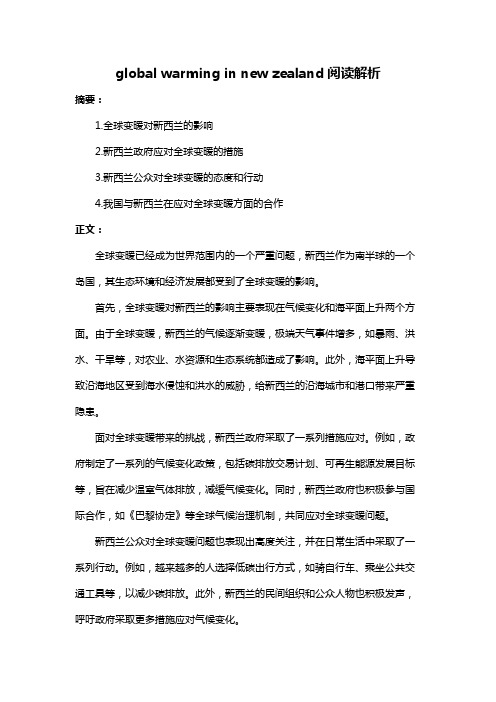
global warming in new zealand阅读解析摘要:1.全球变暖对新西兰的影响2.新西兰政府应对全球变暖的措施3.新西兰公众对全球变暖的态度和行动4.我国与新西兰在应对全球变暖方面的合作正文:全球变暖已经成为世界范围内的一个严重问题,新西兰作为南半球的一个岛国,其生态环境和经济发展都受到了全球变暖的影响。
首先,全球变暖对新西兰的影响主要表现在气候变化和海平面上升两个方面。
由于全球变暖,新西兰的气候逐渐变暖,极端天气事件增多,如暴雨、洪水、干旱等,对农业、水资源和生态系统都造成了影响。
此外,海平面上升导致沿海地区受到海水侵蚀和洪水的威胁,给新西兰的沿海城市和港口带来严重隐患。
面对全球变暖带来的挑战,新西兰政府采取了一系列措施应对。
例如,政府制定了一系列的气候变化政策,包括碳排放交易计划、可再生能源发展目标等,旨在减少温室气体排放,减缓气候变化。
同时,新西兰政府也积极参与国际合作,如《巴黎协定》等全球气候治理机制,共同应对全球变暖问题。
新西兰公众对全球变暖问题也表现出高度关注,并在日常生活中采取了一系列行动。
例如,越来越多的人选择低碳出行方式,如骑自行车、乘坐公共交通工具等,以减少碳排放。
此外,新西兰的民间组织和公众人物也积极发声,呼吁政府采取更多措施应对气候变化。
我国与新西兰在应对全球变暖方面有着广泛的合作空间。
双方可以在气候变化政策、可再生能源技术、碳排放交易等方面开展合作,共同应对全球变暖挑战。
此外,两国还可以加强在南极洲等极地地区的科研合作,共同研究气候变化对极地生态环境的影响。
总之,全球变暖对新西兰的影响是多方面的,新西兰政府和公众正在积极应对这一挑战。
- 1、下载文档前请自行甄别文档内容的完整性,平台不提供额外的编辑、内容补充、找答案等附加服务。
- 2、"仅部分预览"的文档,不可在线预览部分如存在完整性等问题,可反馈申请退款(可完整预览的文档不适用该条件!)。
- 3、如文档侵犯您的权益,请联系客服反馈,我们会尽快为您处理(人工客服工作时间:9:00-18:30)。
雅思阅读练习题:Global warming很多同学在备考雅思时找不到雅思阅读练习题,今天新通教育小编为大家带来了雅思阅读练习题一篇,希望对大家有用,更多雅思阅读练习题目请关注新通教育官网。
Global warmingYou should spend about 20 minutes on Questions 1-13 which are based on Reading Passage 1 below.Questions 1-5 Reading Passage 1 has six paragraphs A-F .Choose the most suitable headings for paragraphs B-F from the list of headings below.Write the appropriate numbers i-viii in boxes 1 - 5 on your answer sheet.List of Headingsi The plaintiffs?viewpoints on regulating emissionii Federal government being taken to courtiii Possible impact of the case on other lawsuitsiv Regulating air pollution by twelve Statesv Stance of the Bush administrationvi Viewpoints of Bill Clinton on regulationvii The call for emission caps and reduction1viii Uncertainty in ruling by the Supreme CourtExample AnswerParagraph A ii1. Paragraph B _____2. Paragraph C _____3. Paragraph D_____4. Paragraph E _____5. Paragraph F _____Green states take the federal government to courtNov 30th 2006From The Economist print editionA WHEN the subject is global warming,the villain is usually America . Although it produces a quarter of the greenhouse gases that are heating up the planet,it refuses to regulate them. When other countries agreed on an international treaty to do so——he Kyoto protocol——America failed to ratify it. But not all American officialdom is happy with the federal government's stance. In fact,12 states disagree so fiercely that they are suing to force it to curb emissions of carbon dioxide,the most common greenhouse gas. The Supreme Court heard argument in the case on November 29th. The outcome will not be known for months,but the political wind seems to be shifting in favour of firmer action to2counter climate change.B The Clean Air Act charges the Environmental Protection Agency (EPA) with regulating air pollution from vehicles. But the EPA argues that Congress did not intend to include CO2 under that heading,and that to do so would extend the EPA's authority to an unreasonable extent. Furthermore,it contends that regulating emissions would not do good unless all or most other countries did the same. That is in keeping with the policies of President George Bush,who opposes mandatory curbs on emissions and believes that any international accord on global warming should apply to all countries——unlike the Kyoto protocol,which exempts poor ones,including big polluters such as China and India . Ten states,among them gas-guzzling Texas and car-making Michigan,also back the EPA.C The plaintiffs comprise 12 states,three cities,various NGOs,and American Samoa,a Pacific territory in danger of vanishing beneath the rising ocean. They are supported by a further six states,two power companies,a ski resort,and assorted clergymen,Indian tribes and agitated grandees such as Madeleine Albright,a former secretary of state. They point out that under the administration of Bill Clinton,the EPA decided that it did have the authority to regulate CO2. The act,they note,says the EPA should regulate any air pollutant that "may reasonably3be interpreted to endanger public health or welfare". It goes on to define public welfare to include "effects on soils,water,crops,vegetation,manmade materials,animals,wildlife,weather,visibility,and climate".D The Supreme Court may give a mixed ruling,decreeing that carbon dioxide is indeed a pollutant,but one the EPA is free to ignore or regulate as it pleases. Or it might dismiss the complaint on the grounds that the plaintiffs did not have the right to lodge it in the first place. In theory,they must prove that the EPA's foot-dragging has caused them some specific harm that regulation might remedy——a tall order in a field as fraught with uncertainty as climatology. Even if the court found in the plaintiffs' favour,rapid change is unlikely. By the time the EPA had implemented such a ruling,Congress would probably have superseded it with a new law.E That is the point,environmental groups say. They want Congress to pass a law tackling global warming,and hope that a favourable court ruling will jolly the politicians along. Moreover,the case has a bearing on several other bitterly-contested lawsuits. Carmakers,for example,are trying to get the courts to strike down a Californian state law based on certain provisions of the Clean Air Act that require them to reduce their vehicles' CO2 emissions. If the Supreme Court decides that the act does not apply to CO2,then the Californian law would also be in jeopardy.4That,in turn,would scupper the decision of ten other states to adopt the same standard.F However the Supreme Court rules,many state governments are determined to tackle climate change. California is in the vanguard. Its legislature has passed a law that will cap and then reduce industrial emissions of greenhouse gases. Seven eastern states have formed the Regional Greenhouse Gas Initiative,which will treat emissions from power plants the same way. Almost 400 mayors have signed an agreement to cut their cities' emissions in line with Kyoto. Many businesses,even some power companies,would rather see regulation now than prolonged uncertainty. And several of the leading contenders for 2008's presidential election are much keener on emissions caps than Mr Bush. Change is in the air.Questions 6-9 Do the following statements reflect the views of the writer in the reading passage?In boxes 6 - 9 on your answer sheet writeYES if the statement reflects the views of the writerNO if the statement contradicts the views of the writerNOT GIVEN if there is no information about this in the passage6. Texas and Michigan are among the 12 states which call for regulating air pollution.57. An American island is in danger of disappearing beneath the rising ocean.8. The plaintiffs can prove that the EPA foot-dragging has caused them harm that the regulation might remedy.9. The Supreme Court's ruling may influence the results of other lawsuits.Questions 10-13 Answer the following questions with NO MORE THAN THREE WORDS each in boxes 10 - 13.10. What country produces 25% of the world's greenhouse gases?11. Which president opposes mandatory curbs on emission,George Bush or Bill Clinton?12. Who are trying to get the courts to strike down a Californian state law that require them to reduce their vehicles' CO2 emissions?13. What would some power companies rather see than prolonged uncertainty at present?6。
